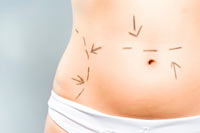Want to Lose Weight? Do this...
There is a little secret known as carbohydrate rotation that has been used for years by bodybuilders and models to get in shape fast. This method will allow you to drop fat while keeping your muscle. It is easy to do and yields great results for anyone.
This is a short term diet strategy that consists of three principles:
1. Cut way back on fat intake
2. Limit carbohydrate consumption
3. Increase protein consumption
Cutting back on fats is obvious. Get rid of butter, oils and fried foods from your diet. Eat only lean protein and skinless chicken. Pretty simple.
In addition to dropping fats from your diet you will want to limit carbohydrates which will suppress the release of insulin. One of the effects of insulin is to increase the uptake and storage of dietary fat. By limiting carbohydrates you choke off the supply of insulin, thus increasing fat loss.
By adding extra protein to your diet you keep from using existing muscle tissue as fuel. One of the downsides to limiting carbohydrate intake is that after about 3-5 days your body will enter a state of ketosis. This happens when the muscles no longer have a source of glycogen (stored carbohydrates) to burn as fuel. Once you deplete your glycogen the body looks for another source of energy and it will break down your muscles for fuel if you aren't eating enough protein.
Here is my 7 step guide to manipulating carbohydrates to promote maximum fat loss while maintaining your existing muscle mass. This guide assumes you are eating six meals a day already and drinking lots of water (64oz a day or more if possible). It also assumes you are exercising daily.
#1 Think low carbs, not high fat! You're not doing your body a favor by using diets that eliminate carbohydrates completely and have you eating mounds of high fat foods like hamburger, bacon and whole eggs. The winning strategy is to limit carbohydrates AND fat while making lean protein your key ingredient to stave off muscle loss.
#2 Cut it in half Divide your normal daily carbohydrate intake by two. A normal 200 pound male will usually eat about 500 grams of carbohydrates daily. If you have no idea how many carbohydrates you eat in a day you can track your daily food intake online at http://www.fitday.com It's a free and easy to use tool. Follow the one half usual carbs per day (250g) for one day. Next, slash that reduced total in half once more (125g) and stick with that lowered carbohydrate intake for two more days. Spread your carbohydrate intake evenly over the day.
#3 Eat your carbohydrates before and after exercise. During days 4 and 5 you will keep your carbohydrate intake at the reduced levels (125g), but eat carbohydrates only before and after you exercise. Split your carbohydrate intake evenly (62.5g before and 62.5g after exercise). This will help to spare your muscles while depleting carbohydrates in the body and kicking the insulin mechanism into high gear.
#4 Slice carbs to the bone. Now that you have depleted your muscles of glycogen you can really push the envelope for two days. Your energy at this point will likely be very low, but stick it out, it's only two days and this is where you get the greatest fat loss. Cut your carbohydrates back to 75 grams for the next two days. Try to eat the majority of your carbs before exercise to give you the energy you need. For the rest of the day the only carbohydrates you will get should come from vegetables.
#5 Switch it up for one glorious day. When you are on a low carbohydrate diet your body will adapt which will slow your metabolism and your rate of calories being burned. You can trick your body by switching things up for one day and keep your metabolism and fat burning in high gear. Increase your carbohydrate intake to 80% of normal (this is 400 grams for the referenced 200 pound male). This increase will fool your body and keep your metabolism high while also providing you with much needed energy at this point.
#6 Don't forget to increase protein. During your reduced carbohydrates you will need additional protein to keep your body from using your muscles as fuel. Follow the schedule below for protein intake to avoid this problem.
Day 1: 1 grams of protein per pound of bodyweight
Day 2 & 3: 1.2 grams of protein per pound of bodyweight
Day 4 & 5: 1.6 grams of protein per pound of bodyweight
Day 6 & 7: 1.8 grams of protein per pound of bodyweight
Day 8: 1 grams of protein per pound of bodyweight
#7 Rinse and repeat. Repeat the previous six steps up to three times and then take a one week break. After several rounds of this plan there is no doubt that you will reach your weight loss goals.
The Total Plan
Day 1: 250 grams of carbohydrates / 1 grams of protein per pound of bodyweight
Day 2 & 3: 125 grams of carbohydrates / 1.2 grams of protein per pound of bodyweight
Day 4 & 5: 125 grams of carbohydrates (62.5g before and 62.5g after exercise) / 1.6 grams of protein per pound of bodyweight
Day 6 & 7: 75 grams of carbohydrates / 1.8 grams of protein per pound of bodyweight
Day 8: 400 grams of carbohydrates / 1 grams of protein per pound of bodyweight
Eat six meals a day
Drink at least 64 ounces of water daily
Exercise daily
-
Why You Dont Need To Count Calories On Your Low Carb Diet
One major upside of many low carb diets, such as Rob Faigins Natural H
-
Harvard’s scientific trick: Healthy food becomes irresistible?
Don’t like the taste of wheatgrass or cod liver oil? How about
-
The Quinoa Super Diet - Acai So 2008
It seems like every week we hear about a new herb, dietary supplement,
-
Sugar Surprise How Much Sugar Are You Eating
Health professionals around the nation are urging people to decrease t
-
Are weight-loss drugs worth trying?
New medications, which may be safer than earlier drugs, have expanded
-
How to Advertise with Flyers
How to Advertise with Flyers© Terri Seymour of www.seymourpro
- DON'T MISS
- Your Junk Food Cravings Stop It Now
- 3 Super Easy Weight Loss Tips For Getting Rid of Those Stubborn Pounds
- Thyroid disease linked to low selenium diet: Study
- Healthy And Fast Weight Loss Ephedra Why The FDA Couldnt Keep Their Ban On It
- The Best Weight Loss Tips Of The Fall Season
- Burn Fat Faster And Have Lasting Health With Two Magical Substances
- How I Lost 51 Pounds In 4 Months Using The Simplest Diet Plan In The World
- Green Tea Weight Loss: the Wonders of Natural Herbs
- New study highlights possible side effects of GLP-1 agonists drugs for type-2 diabetes
- 5 Ways To Lose Belly Fat Without Pills, Potions or Surgery




